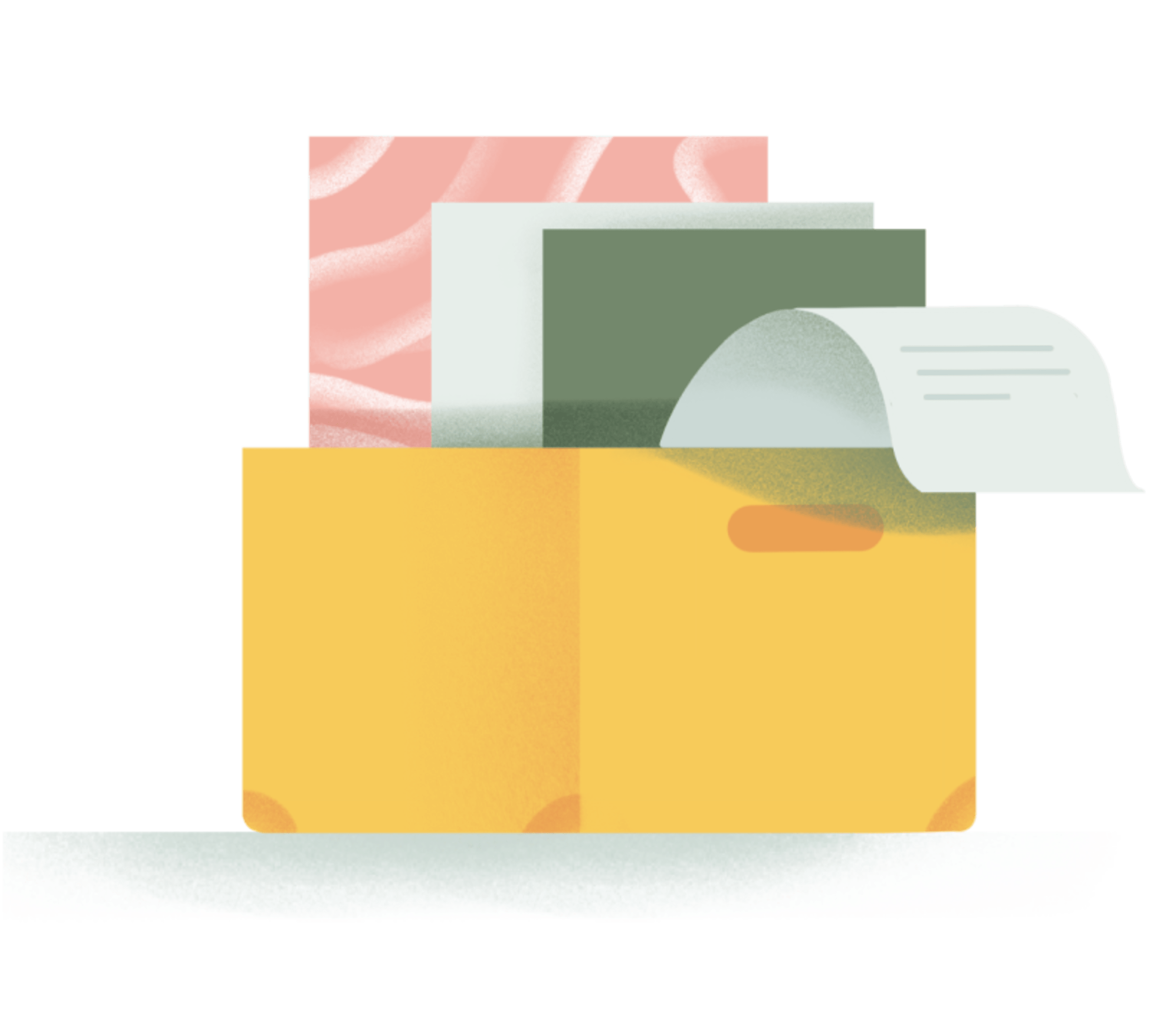It’s great to feel like you’ve hit a groove with Todoist, adding tasks while on the go, creating projects for all your plans, and prioritizing what’s important with priority levels and labels. The challenge for many users comes when your Todoist starts to feel like it’s overflowing with tasks. Suddenly, you go from feeling organized to overwhelmed, and it's difficult to focus on what you most need to do.
That’s where filters come in handy.
Filters let you create custom views for your tasks by combining on all sorts of criteria, like its due date, project, priority level — even the date created or a keyword. You can use filters to keep track of everything — from tasks that are high priority and time sensitive to old tasks you may have forgotten about. Basically, it’s a completely customizable way to group your tasks together.
How do you use filters? A quick primer
Already know how to set up filters? Skip down to our favorite filters from Todoisters.
You can create your own filters in Todoist — for example a filter that helps you focus. If you want to build more “deep work” time into your day, you could create a filter that shows Priority 1 tasks assigned to you that are due today in your Work project:
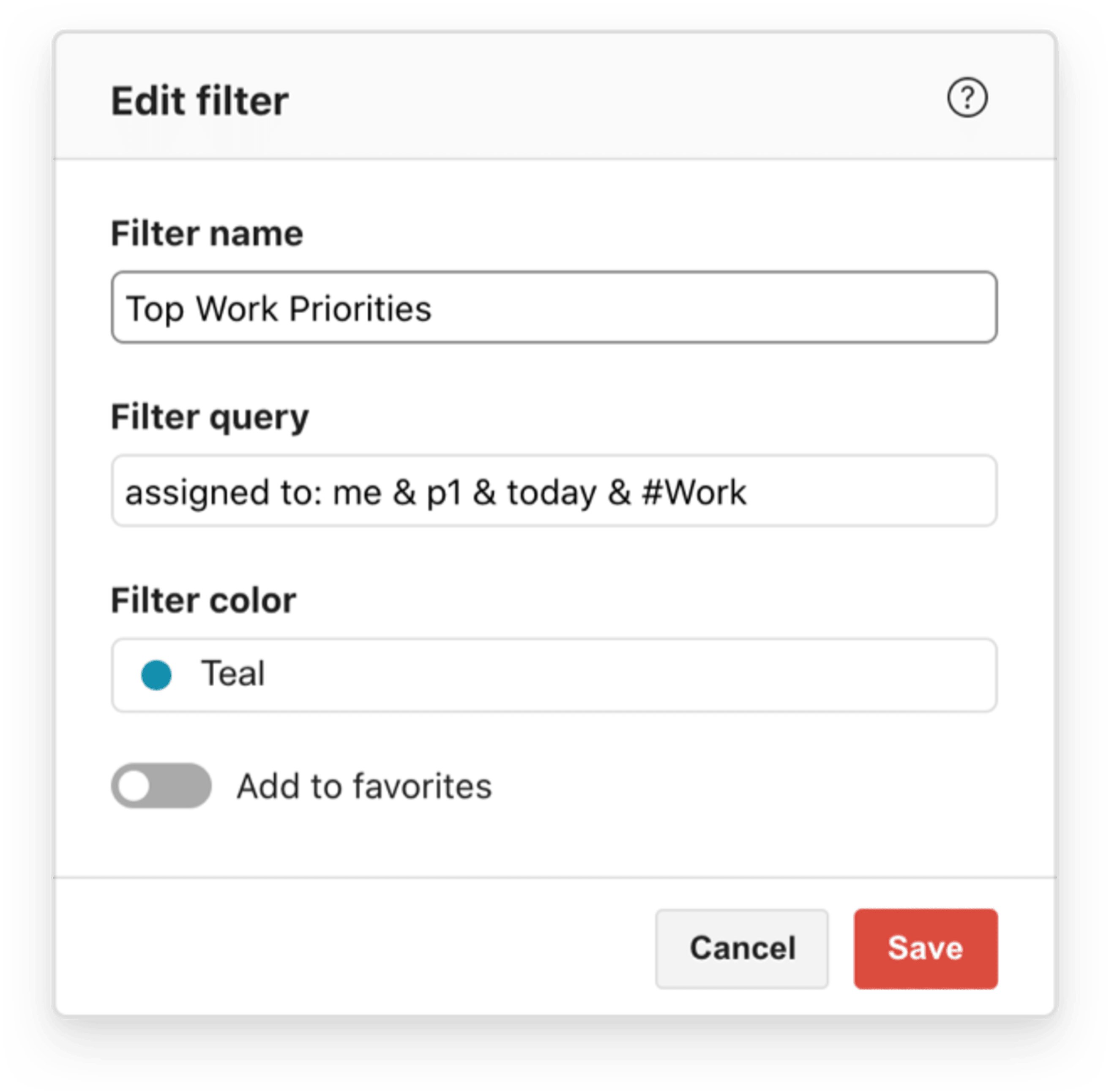
Create a filter for your Top Work Priorities using a filter query.

A view of the Top Work Priorities filter
With filters, you can get as specific as you want.
The power of filters lies in queries, which allow you to create searches that show only certain groups of tasks. You can create filter queries based on:
Due date
Priority level
Label
Project & sub-projects
Date a task was created
Shared project & task assignees/assigners
Keyword(s)

A view of tasks in the No Due Date filter
To combine queries, use the “and” (&) and “or” (|) symbols. For example, the filter “7 days & @waiting” shows all tasks that are due in the next 7 days and are labelled @waiting. The filter (today | overdue) shows all tasks that are overdue or due today.

The query for a Today or Overdue filter
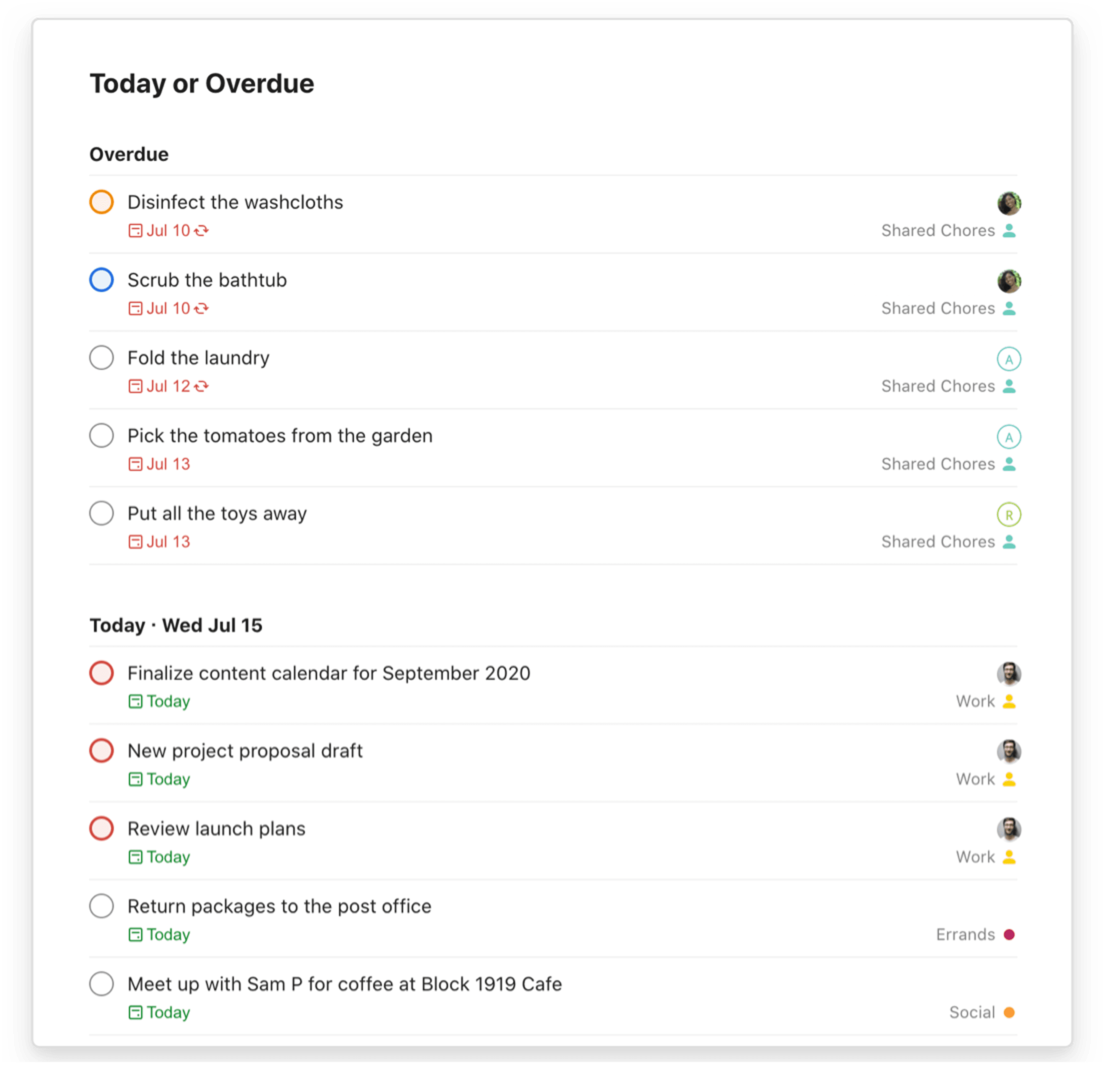
The view of tasks for a Today or Overdue filter
For more on how to create filters, check out our Todoist Filters help page.
Note
💡 Tip: To keep your filters easily accessible, add them as Favorites, and they’ll be at the top of your sidebar, underneath Upcoming view, whenever you need them.
Now that you know how to set up a filter, here are some of our favorite filter examples, from our team at Doist and from Todoisters around the world.
Filters based on time
Creating filters to help manage time is one of the most popular ways Todoisters use filters — helping you keep up with deadlines and plan for the future.
1. Keep track of the next week’s deadlines
Some due dates are aspirational. Others are strict deadlines. Todoister Michael created a filter to distinguish between the two, tracking tasks with deadlines in the next seven days: “I have a label “@deadline” which tells when a project or task has to be finished.
Note
❓Deadline filter query: 7 days & (@deadline) 🔍 Shows you: All tasks due in the next 7 days that are also labelled @deadline
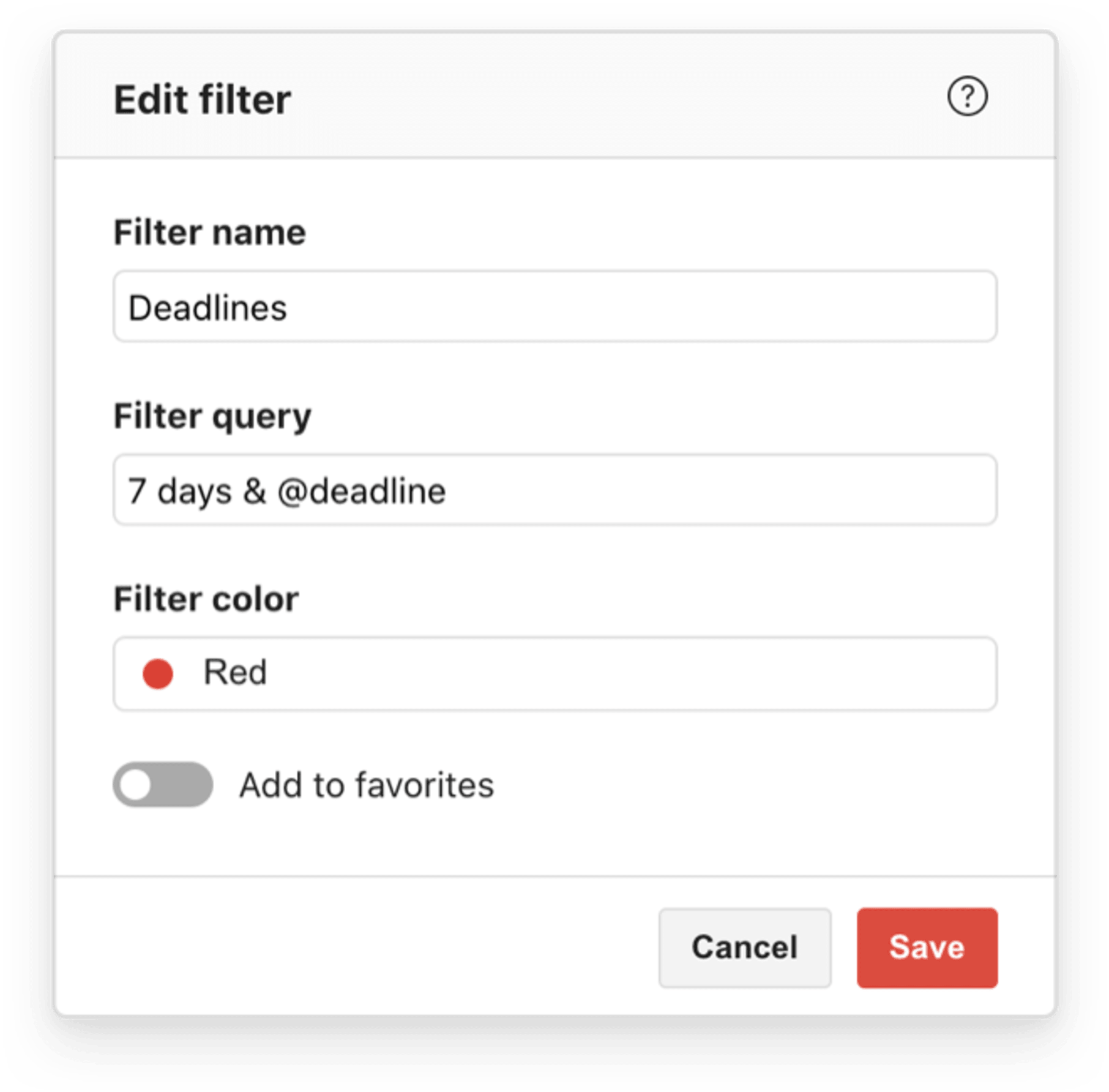
A view of the Deadlines filter
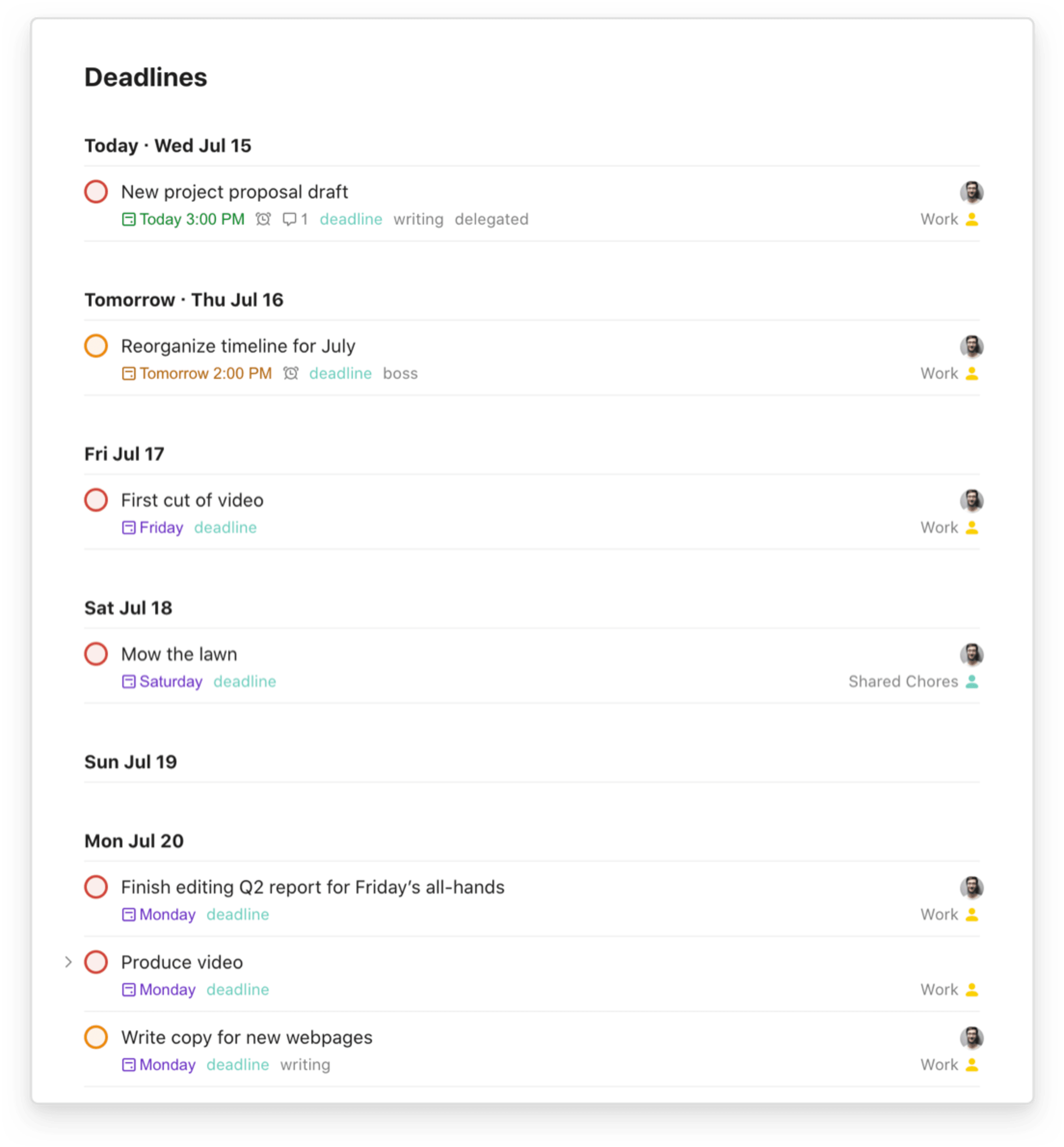
A view of the tasks in the Deadlines filter
2. Focus on high priority tasks due today
Swiss in Hong Kong has a filter called “daytime” to help him focus on what he needs to get done today that is high priority.
Note
❓Daytime filter query: (p1 | p2 | p3) & (overdue | today) & (!assigned to: others) 🔍 Shows you: All tasks that are Priority 1, Priority 2, or Priority 3 that are either overdue or due today and not assigned to others
Note
💡 Tip: If you use Todoist to share projects and assign tasks, adding “!assigned to: others”, which can be read as “not assigned to others,” to your query will ensure that no one else’s tasks show up in your filter.
3. Plan for tomorrow
Dominic, a machine learning engineer at Doist, looks at a filter called “tomorrow” every evening before he goes to bed to review his next day and see how many tasks he has scheduled. “Over time I have learned how much I can fit into a day, so when I want to postpone something, this is the number I look at.”
Note
❓Tomorrow filter query: tomorrow 🔍 Shows you: All tasks due tomorrow
4. Unplug on vacation
Todoister Edditoria makes sure to take a real vacation with a filter called “Holiday,” which brings up activities labeled as “holiday” or “idle” to do while away.
Note
❓Holiday filter query: @ holiday l @ idle 🔍 Shows you: All tasks labeled @holiday or @idle
5. Get a handle on your recurring tasks
Recurring due dates allow you to create tasks that automatically repeat on a regular basis. In order to keep track of all of the tasks he set up to be repeating, Todoister Tony Robertson created a filter with the query recurring.
Note
❓Repeat Tasks filter query: recurring 🔍 Shows you: All tasks with recurring due dates
6. Dust off super old tasks
When you have a lot of important tasks, it’s easy for something to fall through the cracks. Clément makes sure that doesn’t happen with a filter he calls “Super Old,” for tasks that he created a while ago and may have forgotten about— useful when you have a flood of tasks coming in and some don’t make the cut.
Note
❓Super old 😬 filter query: created before: -200 days & !recurring & no due date 🔍Shows you: All tasks created more than 200 days ago that aren’t recurring and don’t have a due date
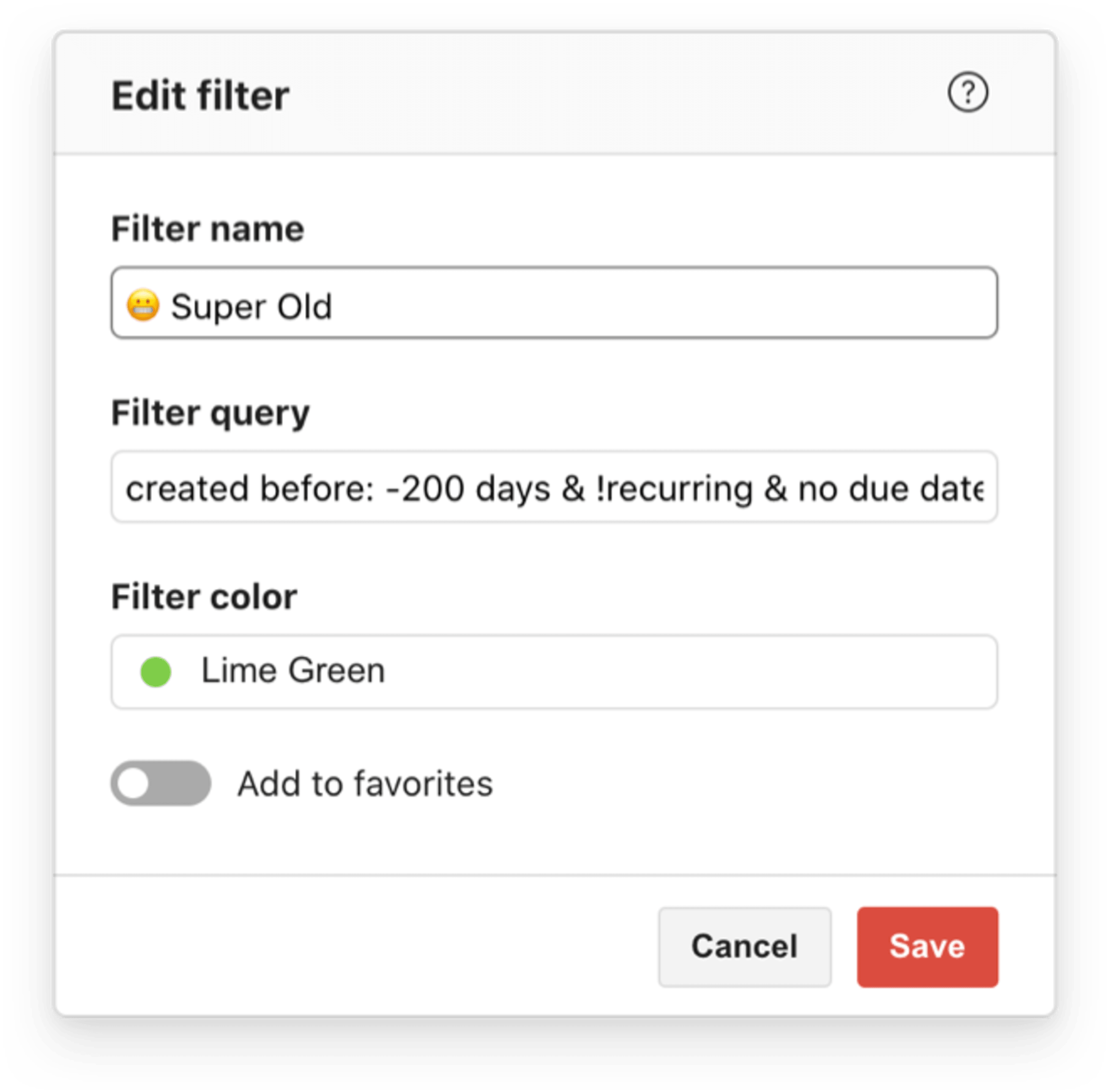
A view of the Super Old filter
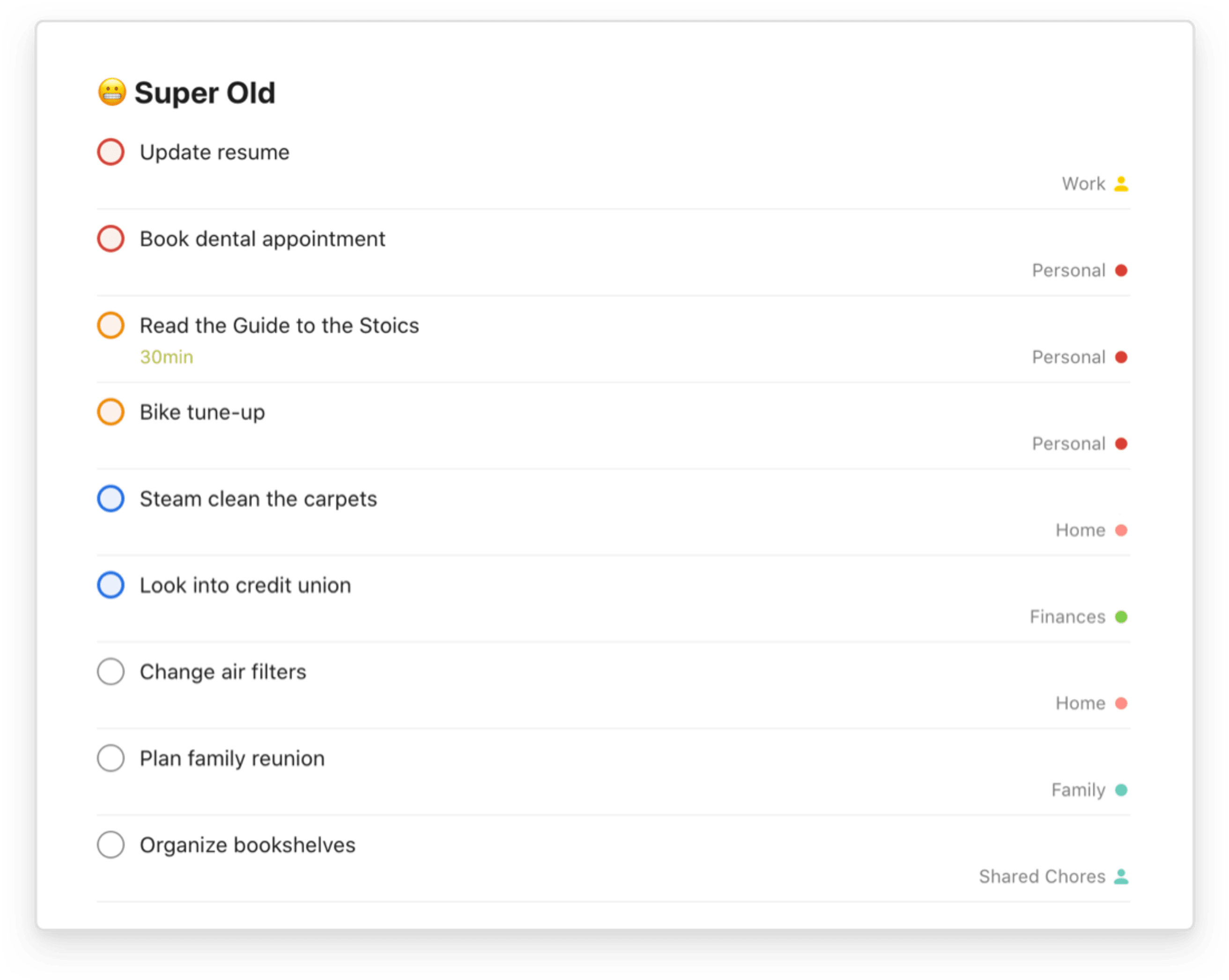
A view of the tasks in the Super Old filter
Filters for work
Here are some filters people use to make sure they get their highest priority tasks and projects done at work.
7. Staying productive and focused at work
Doist’s Head of Marketing, Brenna, keeps her workday sane with two filters. One, called “Today at Work,” allows her to stay focused at work on any given day: “This filter is really helpful for me to focus just on work tasks, since my Today view is full of random and annoying household chores!” she says. Here’s the query:
Note
❓Today at Work filter query: today & @work 🔍Shows you: All tasks due today labeled @work
The filter, “Tomorrow at work,” allows her to plan for her next day at work: “I review this filter every day before I ‘clock out,’ and then, in a journal, block-plan my upcoming day according to the tasks I need to complete and the meetings I have scheduled. This has been a game changer for my productivity!” Here’s the query:
Note
❓Tomorrow at Work filter query: tomorrow & @work 🔍Shows you: All tasks scheduled tomorrow labeled @work
8. Worktime filter
Todoister Evgeny Strelkov created a precise filter called “Worktime”, which allows him to focus on what matters during his work day by only showing tasks in his Work project that have the label office. He uses the “!” symbol to exclude Priority 4 tasks, recurring tasks, and tasks assigned to others. Here’s the query:
Note
❓Worktime filter query: !p4 & !recurring & !assigned to: others & !@goal & (##work | @office) & !@home 🔍Shows you: All tasks that are Priority 1, Priority 2, or Priority 3 in the Work project or labeled @office, excluding tasks that are recurring, assigned to others, or labeled @goal or @home
9. Focusing on specific sub-projects
Aer, who works in product marketing at Doist, is “in love” with their filter for work: “It took me a while to figure out how to get sub-projects included and to filter out tasks assigned to other people, but thankfully it works now.” Here’s the query:
Note
❓Work filter query: (today | overdue) & (##🐙Doist | ##🙋Volunteer) & !assigned to: other 🔍Shows you: All tasks overdue or due today in the sub-projects Doist and Volunteer that aren’t assigned to others
10. Using filters instead of “false” due dates
Todoister Thomas's Work filter displays today’s tasks, overdue tasks, and tasks in his project “MyWork” that aren’t Priority 4, so he can keep an eye on important tasks. “The last section allows me not to set a (false) due date to all tasks but [have] a view on important tasks to take ASAP.” He also has made this custom filter his default view, so it’s the first thing he sees when he loads up Todoist. Here’s the query:
Note
❓Work filter query: (today|overdue) & #MyWork & !p4 🔍Shows you: Tasks that are overdue or due today in the MyWork project, excluding those that are Priority 4.
11. Keep track of upcoming meetings
To see what meetings are in store for him over the next week, Fabio has set up a filter that groups together all of his calls and meetings. Here's the query:
Note
❓Meetings filter query: Next 10 days & (@calls | @meetings) 🔍Shows you: Tasks with the label @calls or @meetings occurring over the next 10 days
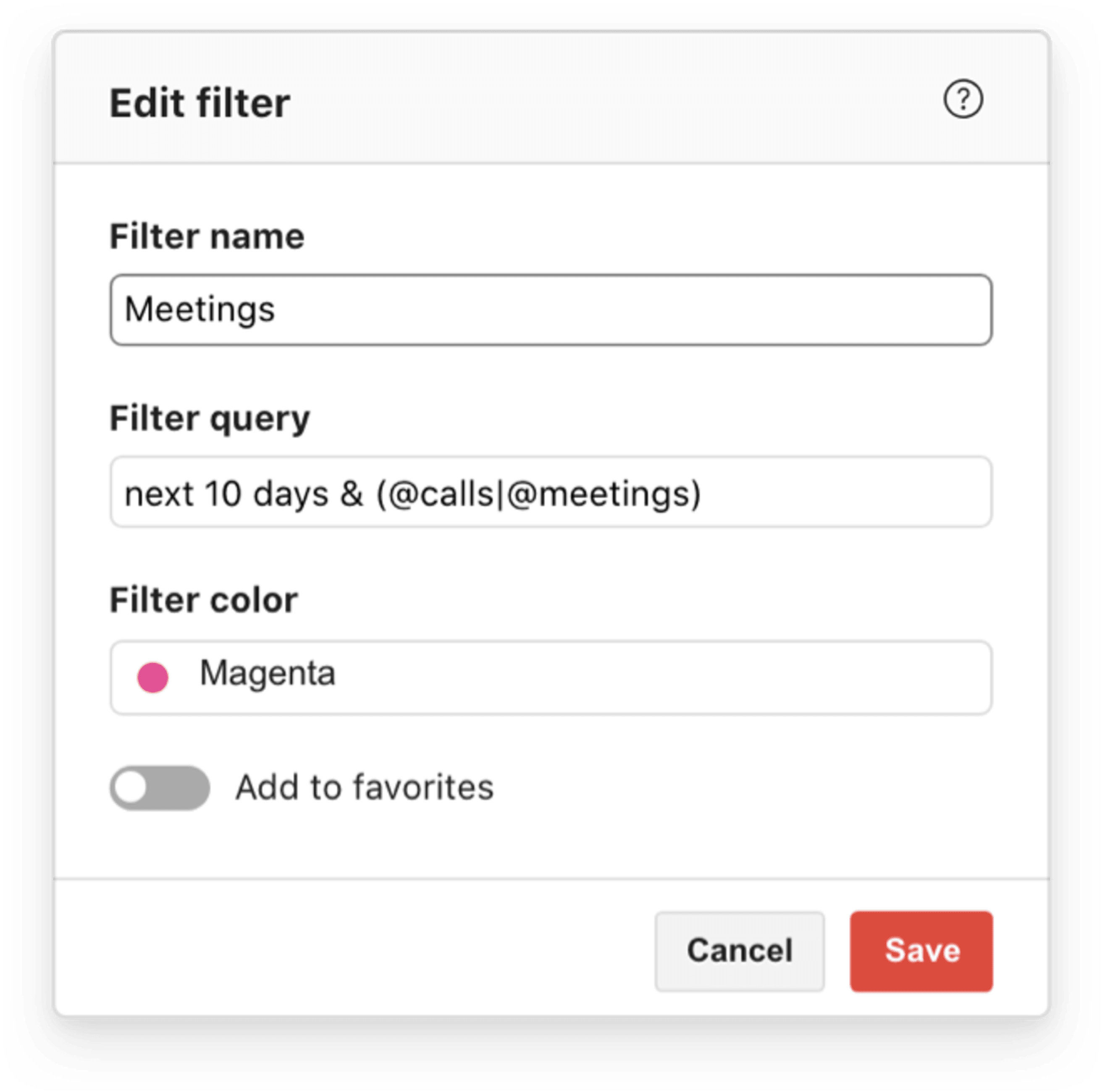
A filter query for Meetings

A view of tasks in the Meetings filter
12. Take a break from work
When he wants to focus on his personal tasks, Chris filters out all of the tasks related to his parent project, TechSmith — the name of the company where he works. He calls this filter “Non-work today.” Here's the query:
Note
❓Non-work Today query: (!##Techsmith & Today), (!##Techsmith & overdue) 🔍Shows you: All tasks due today or overdue, excluding those in the Techsmith project
Filters based on location
Some Todoisters create filters for tasks based on the location where they take place. This allows you to view the tasks you need to do when you are in a certain place, like at your computer, in the office, or in town. Creating this kind of filter is as simple as writing a query with a label like “@intown” & the due date — saving you, for instance, from forgetting to drop off a package while you’re out shopping for groceries!
13. Never miss an errand
Omar, who works in Doist Support, says one of his favorite filters “On the Road Today.” He uses it to keep track of the things he needs to take care of when he leaves his house. It groups tasks with a date of overdue or today with a label he created called @road.
It's a great view that I can quickly pull up to see all the things I have to take care of when I leave my house. It is especially invaluable now during the COVID-19 pandemic to ensure I don't miss something that would cause me to have to climb back into the hazmat suit after I've already made it back home.
Note
❓On the Road Today filter query: (overdue | today) & @road 🔍Shows you: All tasks overdue or due today labeled @road

A filter query for tasks done on the go
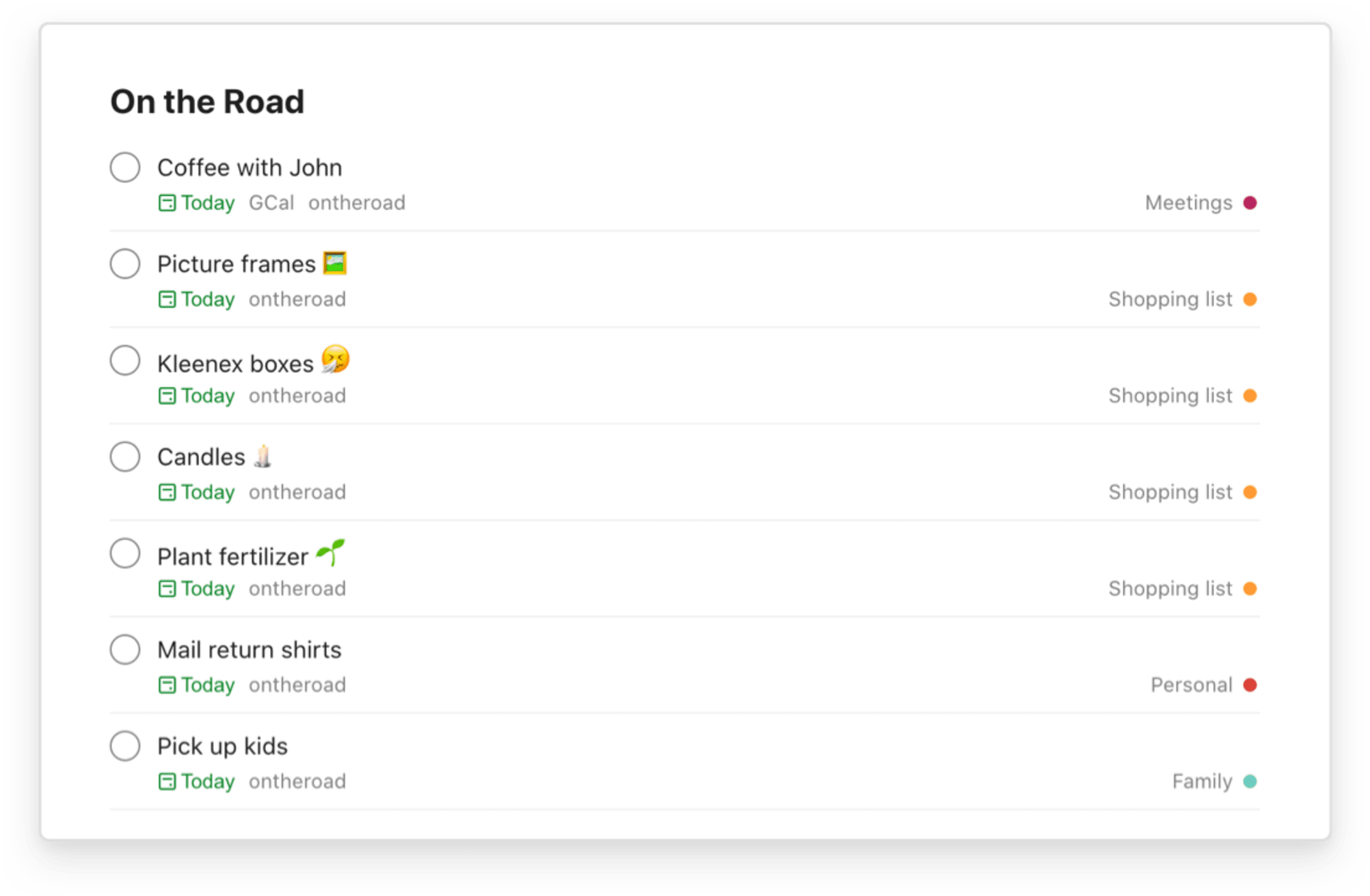
A view of tasks in the On the Road filter
14. See all tasks you can do at your computer
Todoister Happy Heidiv has a filter for tasks she can do easily at her computer. Here’s the query:
Note
❓Computer filter query: 30 days & @computer 🔍Shows you: All tasks due in the next 30 days labeled @computer
Note
💡 Tip: Heidiv mentions she adds “x days” to the start of her filters so they display in date format, which is her preferred view. Give it a shot yourself if you like to see tasks by date instead of the standard task list format.
15. Use a filter for each location
Douglas has created his own personal view of Todoist and labels for different locations — his office, computer, phone, the street, and home. And he has a focus filter for tasks he needs to do at his computer, phone, or office.
Note
❓Focus filter query: (#computer & #phone & #office & today) 🔍Shows you: All tasks in the projects computer, phone, or office that are due today
Filters based on productivity system
Many Todoisters customize their filters to fit a specific productivity strategy or system. Combining queries like priorities, due dates, and labels can help you follow through on their favorite strategies, like time blocking, Eat the Frog, or the Eisenhower Matrix:
16. Time blocking
Kelsy Bostic uses a filter to chunk her time into blocks where she can focus on a particular type of task: “Each block has its own label, so I start my day by assigning each task to the appropriate block/label, and then move through my saved filters of today & each block tag to keep myself organized. It helps so much to look at just the list for that block, rather than digging through the list for the entire day to decide what to do next. It's awesome.”
Note
❓Time blocking filter query: today & @writing (or today & @email, today & @programming, today & @editing — you get the idea 😀) 🔍Shows you: All tasks due today labeled @writing (or @email, @programming, @editing )
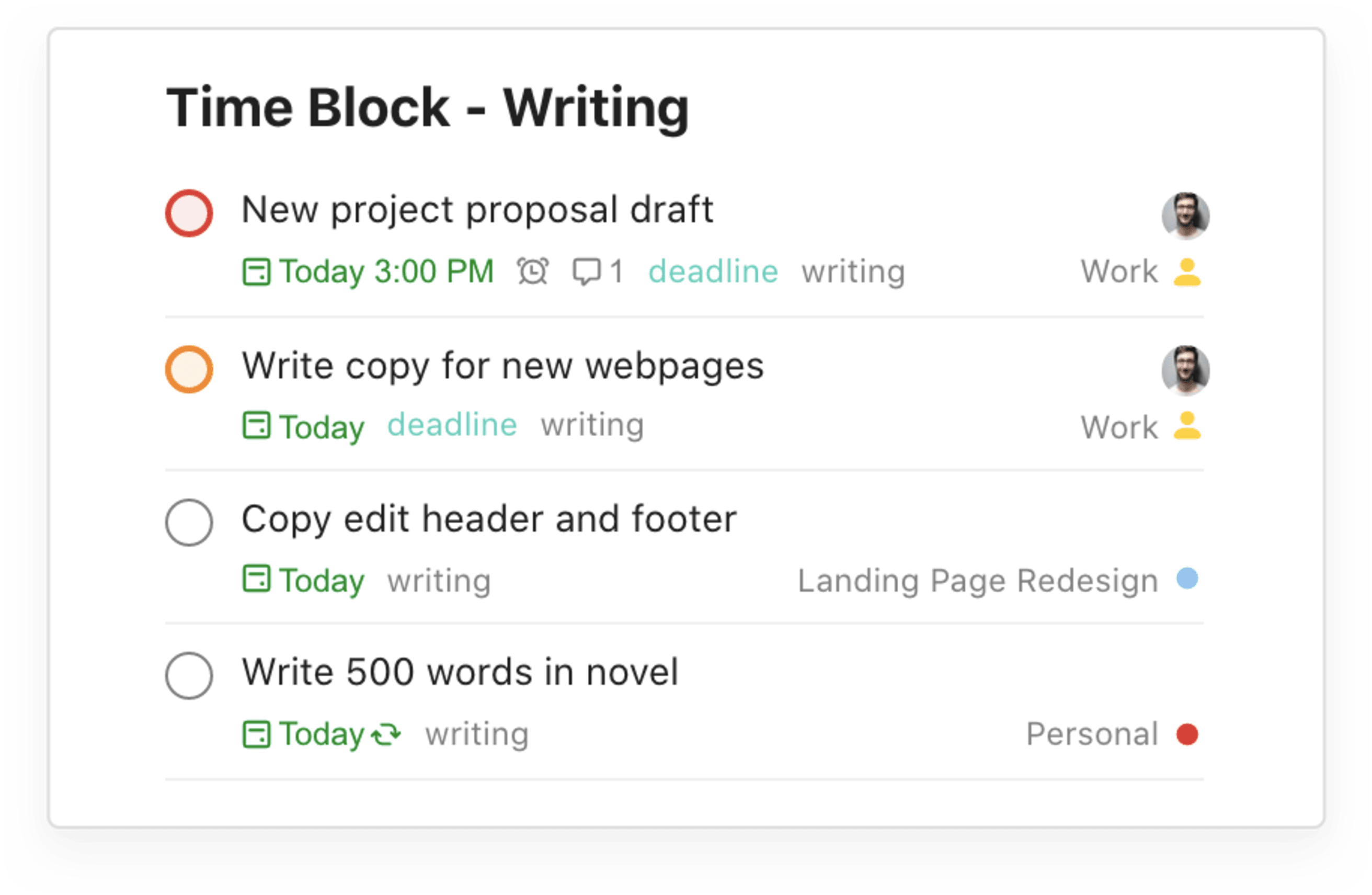
A view of tasks in a writing time block filter

A view of tasks in an email time block filter
17. Energy levels
Willian, API and Integration Programmer at Doist, created labels to help him focus, after reading When: The Scientific Secrets of Perfect Timing by Daniel Pink: “I decided to create peak, trough, and recovery labels, so I can plan my day based on my level of energy. I did some tracking using the daily when tracker and found my average energy levels, so I know more or less when I should use my labels.”
Jennifer Barr uses labels based on mental intensity, like intense, medium, low effort. “Sometimes, prioritizing by your energy will get you the best results, for example it’s hard to write a deep report late in the day after you’ve spent most of your energy,” she says.
You can use labels like these in combination with other fields, like due date, to create a filter for peak energy tasks due this week.
Note
❓ Energy filter query: next 7 days & @intense (or next 7 days & @medium, next 7 days & @low) 🔍Shows you: All tasks due in the next 7 days labeled @intense (or labeled @medium or @low)
18. Eat the Frog
Doist Editor Becky follows the Eat the Frog productivity method. She set up a filter called “Today’s Frog” with all tasks not assigned to others, due that day, that are priority 1. “And then I only have one task at a time marked p1, so only one task shows up in the view at a time.”
Note
❓Today’s Frog filter query: today & p1 &! assigned to: others 🔍Shows you: All tasks due today marked Priority 1 that aren’t assigned to others
Péter has a filter for Eat the Frog tasks — things he doesn’t like to do, like finance and administration tasks. Here’s the query:
Note
❓Finance filter query: (overdue | today) & (@bank | @bills) 🔍Shows you: All tasks that are overdue or due today that are labeled @bank or @bills
19. Deep work
Feniks has a filter that allows them to focus on deep work, with all their work tasks, excluding work routine tasks and appointments. They use it for when they have two hours of quiet time and “can power on some important job and don't want to be distracted by little tasks I can do anytime.” Here’s the query:
Note
❓Deep Work filter query: ##Work & ! #Routine & !#Appointments 🔍Shows you: All tasks in the Work project excluding tasks in the Routine or Appointments sub-projects
20. Eisenhower Matrix
The Eisenhower Matrix is a productivity method focused on distinguishing between what is urgent and what is important using a quadrant — and putting the highest priority on the important tasks.
Onaqvg has set up a filter for each quadrant of the Eisenhower Matrix, where the priority filters each correspond to one of the four quadrants in the matrix.
Allan, the COO of Doist, uses the Eisenhower Matrix in a similar way, but he has gotten a bit more detailed with his filters. He uses the filter “Urgent & Important” to correspond with Priority 1 tasks, “Not Urgent & Important” to correspond with Priority 2 tasks, “Urgent & Not Important” to correspond with Priority 3 tasks, and “Not Urgent & Not” Important to correspond with Priority 4 tasks.
Note
❓Eisenhower Matrix filter query: p1 & overdue & (assigned to: me | !shared), p1 & today & (assigned to: me | !shared) (Use p1 for Urgent & Important, p2 for Not Urgent & Important, p3 for Urgent and Not Important, or p4 for Not Urgent & Not Important) 🔍Shows you: All tasks marked Priority 1 (or Priority 2, Priority 3, or Priority 4) that are overdue or due today and assigned to you

A view of tasks in filters that follow the Eisenhower Matrix productivity method
21. Quick wins
Sometimes your productivity is boosted by a a quick win — checking an easy task off your to-do list, and feeling a bit better about yourself. Todoister Eric set up a filter for his Quick Work Wins, tasks that are 5, 10, or 15 minutes that he can take care of when a meeting ends early or when it’s too late to start something big before the end of the day.
Note
❓Quick Work Wins filter query: @first, (@quick | @5minutes | @15minutes) & ##work 🔍Shows you: All tasks in the @Work project labeled @first and @quick, @5 minutes, or @15 minutes
Todoister Charlie has a similar filter for tasks that are quick and due that day.
Note
❓Today filter query: today & @under10min 🔍Shows you: All tasks due today that are labeled @under10min
Filter based on the people involved
When you manage people or share your Todoist list with your family, you can keep track of tasks that are assigned to others with filters.
22. Prep for 1:1s
Todoister Stuart uses labels for people he works with, to see all the tasks related to a specific person, like his boss, or with relevant stakeholders. He can use this to create a filter that can help him come prepared for 1:1 meetings with his boss by pairing the @boss label with a due date query.
Note
❓1:1 Filter query: next 7 days & @boss 🔍Shows you: All tasks due in the next 7 days labeled @boss
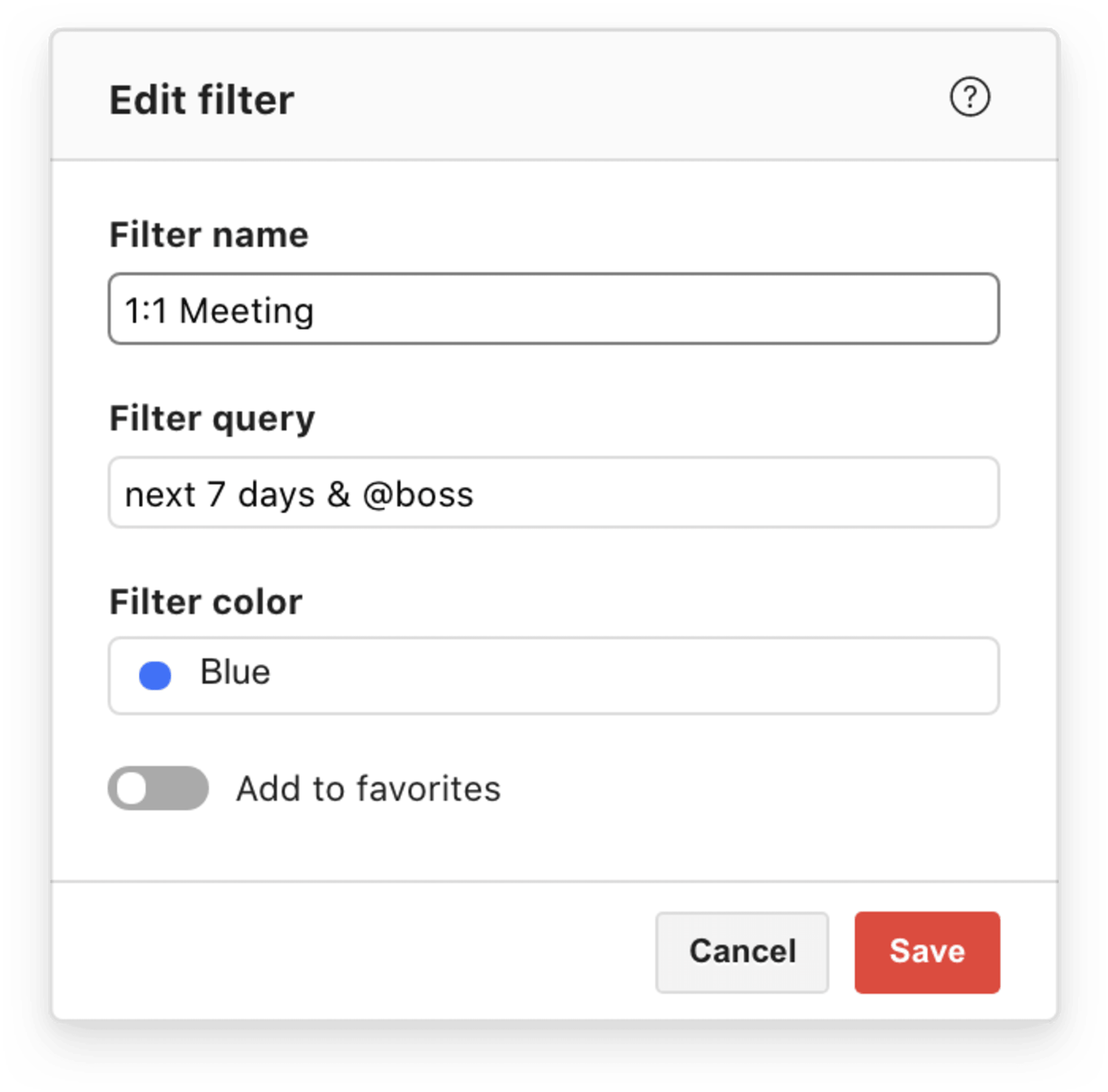
A filter query for 1:1 Meetings
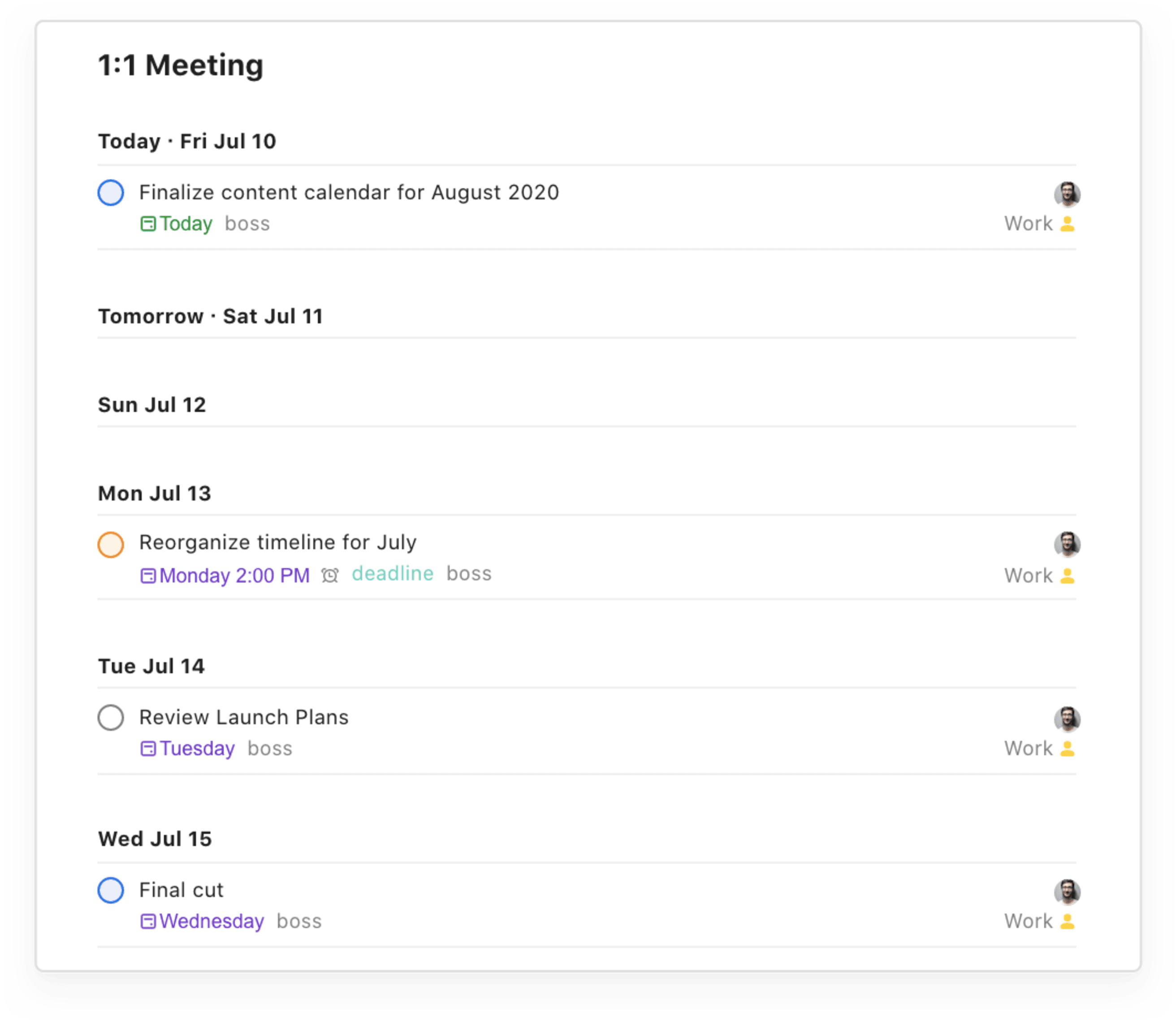
A view of tasks in the filter for 1:1 Meetings
23. Keep track of what you’re waiting on from others
Markus has a filter to keep track of all work related tasks where he is “waiting for someone else to do something.” It’s a useful filter if, for instance, you want to keep track of an important task that is currently with a colleague.
Note
❓ Waiting Work filter query: #Work & @waiting 🔍Shows you: All tasks in the Work project labeled @waiting
24. Delegated tasks
Todoister Sven has a few views that he swears by to help him keep track of tasks he has delegated. He looks at all tasks that are his own, then reviews all the tasks that have been delegated to him. This is useful when you’re overseeing tasks from a lot of people but they aren’t in Todoist — you can label them as “@delegated” so you know they came from somewhere else.
Even better is if you’re all in the Todoist project, and the task can be assigned directly to the right person.
Note
❓Delegated Tasks query: p1 & @delegated & #Work 🔍Shows you: All Priority 1 tasks with the label @delegated in the Work project
If you are feeling in a rut with your productivity system, or like you aren’t getting the tasks that you’ve wanted to work on accomplished, filters are a great tool to turn to. As Todoist Ambassador Victor Campuzano says:
I think every productivity system tends to deteriorate with the pass of the time. We can't control neither avoid all the factors of the system, so maintenance is necessary. I use these filters occasionally to make sure there's no hidden dark corner in my system with a lot of tasks that I will never complete. Things that I considered important but maybe not now.
Share your stories about your favorite filters with us and how they work in the comments or @todoist.
Note
Learn more about working with filters in Todoist from Carl Pullein, productivity expert and Todoist Ambassador. In this insightful video, he walks us through how to maximize your daily workflow using filters.

